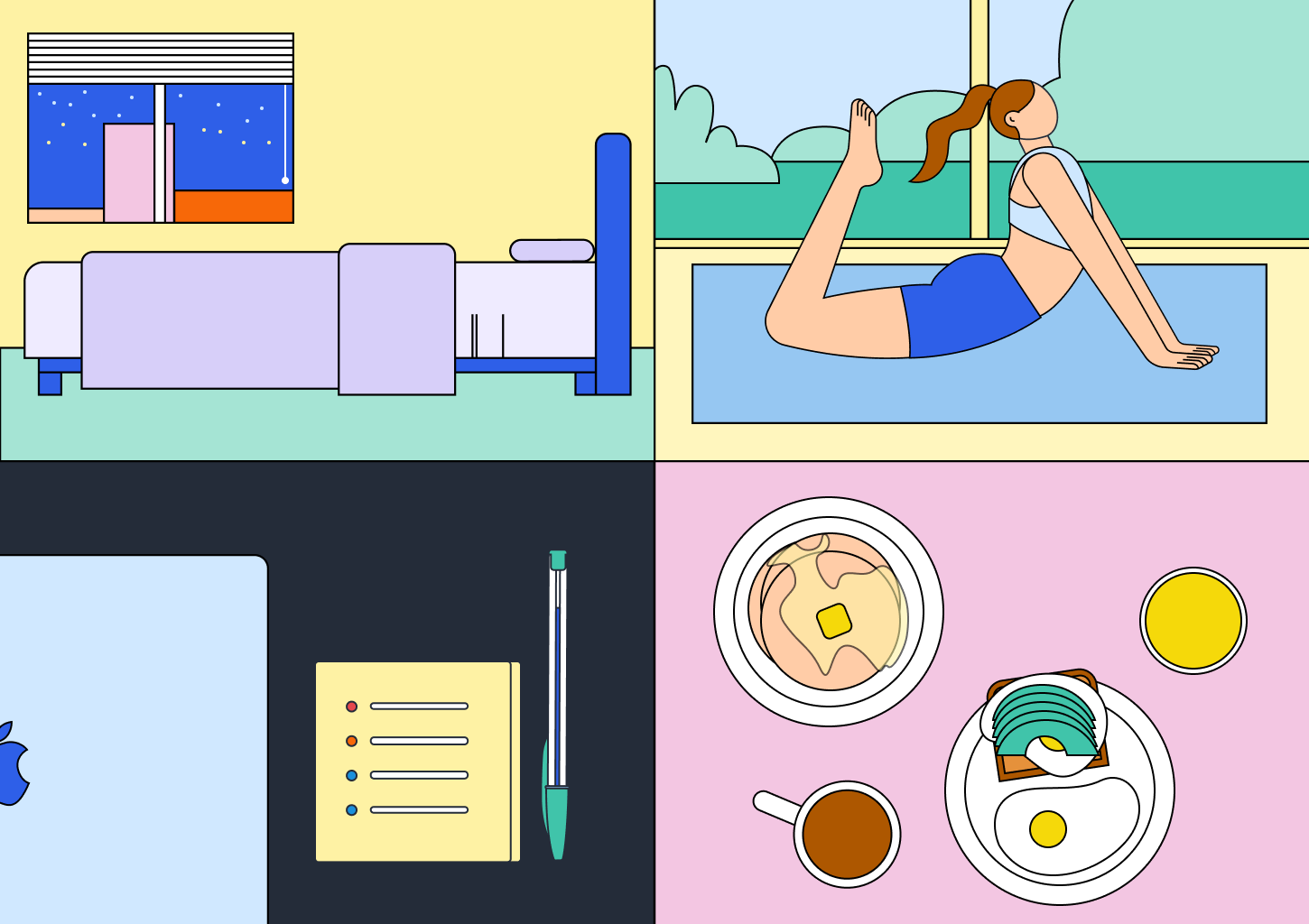Self-designing a productive workday

At Float, we work fully remote, communicate asynchronously, and have the flexibility to choose our hours based on when we work best.
This style of working demands a high level of self-awareness and discipline. It also requires creativity, as we have the opportunity to self-design our workday in a way that is uniquely fulfilling and productive for each of us.
My ideal workday has varied based on where I’ve lived, what I’m working on, and over the last 18 months, circumstances like whether we’re in or out of lockdown. In the three years that I’ve been working asynchronous remote with Float, I’ve been able to refine how I approach self-designing a productive workday that allows me to make the most of my time and live my best work life. Here are my tips.
Learn your triggers for being in a state of flow
The experience of being so immersed in an activity that you lose track of time is known as the flow state.
“Flow is simply that optimal state of mind in which we feel and perform our best, and it doesn’t have to be mysterious or elusive.”
TED Ideas
There’s lots of research and ideas on ways to get yourself into a state of flow, and everyone will have different triggers that best suit them. For me, being attentive to what I need both physically and psychologically to do my best work is a continuous process.
Physical environment
Remote work forced me to ask myself what I needed in my physical workspace to be inspired and motivated each day. When I joined Float I had just moved to New York and knew immediately that I didn’t want to be working from my tiny apartment every day (if ever)! I had the freedom to choose my own work space and it made me actively consider what factors were important to my ideal workspace set up. For example, natural light is important for making me feel energized. When I was looking at different co-working spaces, lockable, windowless cubicles were a definite no-go for me!

Working from a large monitor is also pretty much a non-negotiable. Unfortunately, that kills the remote work fantasy of being by the pool on a laptop all day! Even when I’m away somewhere, I take a monitor with me (or try to find one that I can work from).

Your physical environment must be a space that you enjoy being in, especially when you’re working remotely. It’s why giant companies like Google and Uber have historically invested so much into their office spaces. If you’re working from home, I recommend setting up your workspace so that it’s separate from your other rooms (or separating it as best you can if space is at a premium). For example, when I was living in a one-bedroom apartment and didn’t have a separate area I could work from, I would pop a throw over my monitor to signal logging off at the end of each workday.
Physical and psychological states
Recently, I’ve been reading about the effect that the flow state has on the brain and considering what impact different physical and psychological states have on my work. For instance, exercising early in the morning makes me feel more productive and optimistic when I start my workday. When I have a regular yoga practice, my ability to concentrate and focus is better.
I’ve also started to observe my best state of being for different tasks and what some of my triggers are. Even though we’re fully remote, I always get a buzz when I get an opportunity to sync with the team. Therefore, if I know that I have a synchronous meet, I’ll consider what work would benefit best from this energy. For example, after our Remote Roadshow, I was feeling exceptionally inspired, with lots of content ideas for our blog. Recognizing this, I took the opportunity to reach out to several team members while my enthusiasm and excitement levels were high to book blog post contributions from them.

Knowing what energizes you and helps you get into different zones of productivity is a powerful insight to have about yourself, and can be utilized whenever you need it!
Structure your workday based on your energy levels
Earlier this year, Linda, our people ops manager did a quick poll across the Float team to find out who identifies as a morning person and who is an evening person. The result was about 50/50 across the team! Even among our co-founders Lars and Glenn, the result is split—Lars prefers to work late into the evening while Glenn feels most productive first thing in the morning!
The fact is, we’re all different, and we should structure our workdays accordingly (if we can). Lately, I’ve been planning when I do specific tasks based on my best four hours of the day, i.e., the hours that I feel my most productive and best self. I’ve also been observing which hours of the day I find particular tasks more enjoyable and easier to tackle. For example, I prefer to do any analysis or strategy work that requires me to think deeply in the mornings as I find mornings more conducive to working in flow.
I tend to hit a bit of a lull in the afternoons so I try to leave the time for lighter tasks or those that are less mentally strenuous. When I have writing-related tasks (like this blog post), am briefing posts to team members, or proofreading their outlines, I like to structure my day with time blocks in the evening to work on them. This might mean taking a longer lunch break in the day or finishing at 3 p.m. and then coming back online at around 7 p.m, for a few hours. I've even curated a Spotify playlist that's specially for when I'm working late into the evening (vs. my Deep Work playlist that I listen to during the day).
If your workplace has flexible hours, I encourage you to observe when your best hours to get into a state of flow are, and what types of work requires you to be in different mental modes. This knowledge will help you structure your day more effectively.
Work life balance requires work life boundaries
I first heard this phrase from a friend after she read my interview on Balance the Grind, and it resonated with me.

I don’t always view my work as work—i.e., it being something I have to do vs. want to do—however, I understand and believe in the importance of finding a balance that works best for each of us. And, to Yara’s point, finding that balance requires knowing what your boundaries are.
Fortunately, asynchronous communication means that we don’t have a culture of immediate replies and have a higher sensitivity to being respectful of each other’s time. This helps to remove some of the pressure to be on at all hours, and enables better boundaries. However, knowing your boundaries is one part; practicing them is another.
It’s why we’ve introduced No FOMO Week at Float—our team’s inaugural, annual all-team holiday. In June of this year, I took a full week offline. I resisted all urges to check Slack, read our weekly Float internal newsletter, or engage with work (admittedly, it helped that I was somewhere with very little reception!). Being able to completely switch off and recharge meant that I was actually excited and energized to return to work.
While a week’s holiday is a one-off, I also find opportunities to be offline in my workday. When I run, it’s always without a phone, and obviously when I go for a surf too! At lunch time, I’ll sometimes walk to the beach or eat lunch outside without my phone or with Slack notifications switched off.
Productivity inspires creativity and vice versa
When we start to tune into what sets us up to be more productive, we begin to rethink what our ideal workday could look like. And when we start to plan our workdays to enable states of flow that are unique to us, we’re more likely to be productive!
I’ve always been guilty of Mondayitis. It’s my least favorite day of the week and I usually don’t feel like my best self until the day is nearly over. For the last few weeks, I’ve tried mixing it up a little. One week, instead of my usual 8:30 a.m. start, I didn’t come online until 10:30 a.m. That two hours in the morning felt like an indulgent little window for myself to do things around the house, get a nice slow cup of coffee, and relax before starting my workday.
I took a late 3 p.m. lunch break and then worked through until 7 p.m. when it was time to head to touch football. Last Monday, I was on a train at 7 a.m. to work from my friend’s house for the day (alongside her seven-week-old baby). She was happy to have some company in the house, and we were able to enjoy a delicious lunch together. It was the best Monday I’ve had yet! Today (as I'm writing this) I started at 8 a.m. but got up early and made sure to get down to the beach for a short meditation and swim before logging on. I took a longer break in the afternoon so I could come back online to write this blog post this evening.
As much as I believe in the importance of routine and structure, mixing up my Monday from time to time has helped me feel more inspired and motivated on what usually feels like my least productive day of the week.
At Float, we talk a lot about the importance of trust in asynchronous remote teams. I believe trust is also an important ingredient to self-designing a productive workday. Managers need to trust their team to choose where and when they work best and team members need to trust themselves to:
• know what their triggers for flow are (and structure their day accordingly),
• practice their work and life boundaries, and
• be willing to get creative to find their maximum productivity!











